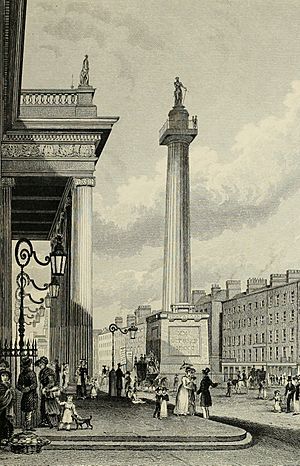Thomas Kirk (sculptor) facts for kids
Quick facts for kids
Thomas Kirk
|
|
|---|---|
| Born | 1781 Cork, Ireland
|
| Died | 19 April 1845 (aged 63–64) Dublin, Ireland
|
| Resting place | Mount Jerome Cemetery |
| Nationality | Irish |
| Known for | Sculpture |
Thomas Kirk (1781 – 1845) was a famous Irish sculptor. He created many beautiful statues and memorials. His art can still be seen in important buildings across Ireland.
Thomas was born in Cork. He studied art at the Dublin Society's School. He even won prizes there in 1797 and 1800. Later, he worked for Henry Darley, a skilled builder. Darley was known for cutting stone in Meath.
Kirk became very good at making detailed carvings. These carvings are called "reliefs." He made them for fireplaces and monuments. You can see his work in places like the Royal College of Surgeons. His art is also in the Royal Dublin Society and Trinity College, Dublin library. He was also a member of the Royal Hibernian Academy.
Contents
Famous Sculptures by Thomas Kirk
Thomas Kirk made many important sculptures. He was known for his detailed work. His art is still admired today.
One of his first big projects was in 1809. He created the statue of Nelson for Nelson's Pillar in O'Connell Street, Dublin. Sadly, this monument was destroyed in 1966.
Kirk also made a statue of Thomas Spring Rice in Limerick. Thomas Spring Rice was a Member of Parliament (MP). He was also a Chancellor of the Exchequer, which is like a country's finance minister.
Another of his works was a bust of Arabella Cope. A bust is a sculpture of someone's head and shoulders. This bust was shown in 1819. You can see it today at Knole in England.
Kirk often made memorials for churches. His favorite carving was of the Good Samaritan. This scene shows someone helping a person in need. It was a popular choice for memorials to doctors or religious leaders.
Thomas Kirk's Family and Legacy
Thomas Kirk passed away in 1845. He was buried in Mount Jerome Cemetery in Dublin.
His sons, Joseph Robinson Kirk and William Boyton Kirk, also became sculptors. His daughter, Eliza Kirk, was also a sculptor. Even his grandson, Thomas Stewart Kirk, followed in his footsteps. His eldest daughter, Mary Anne, was a talented musician and scholar.
After his death, Kirk's works were still displayed. They were shown at big exhibitions. These included the 1852 Irish Industrial Exhibition. They were also at the 1852 Royal Hibernian Academy exhibition. His art was also part of the 1872 Dublin Exhibition of Arts.
Notable Memorials by Thomas Kirk
Thomas Kirk created many memorials found in churches across Ireland. Here are some examples:
- Jane Vernon Memorial: This memorial is in St. Mary's church in Carlow. It shows people mourning Jane Vernon. It also features tools that represent her talents, like a harp and an easel.
- Nathaniel Sneyd Memorials: Nathaniel Sneyd had two memorials. One is in Cavan. The other is a life-size statue in Christ Church Cathedral, Dublin. It shows him lying down with a weeping figure.
- Rev. Joseph Storey Memorial: This memorial is in Cavan.
- Rev. George Hill Memorial: You can find this memorial in Comber, County Down.
- St. Ann's Church, Dublin: Kirk made several memorials in St. Ann's Church in Dublin.
- John Chambers Memorial: This memorial is in St. George's church in Dublin.
- Thomas Abbott Memorial: This is in Christ Church Cathedral, Dublin.
- Sir John Andrew Stevenson Memorial: This marble monument is in Christ Church Cathedral. It has a bust of Sir John and a choirboy.
- Dr. Spray Memorial: This memorial is in St. Patrick's Cathedral in Dublin.
- Thomas Ball Memorial: Also in St. Patrick's Cathedral.
- Rev. Thomas Clarke Memorial: This is in the Pro-Cathedral in Dublin.
Images for kids



